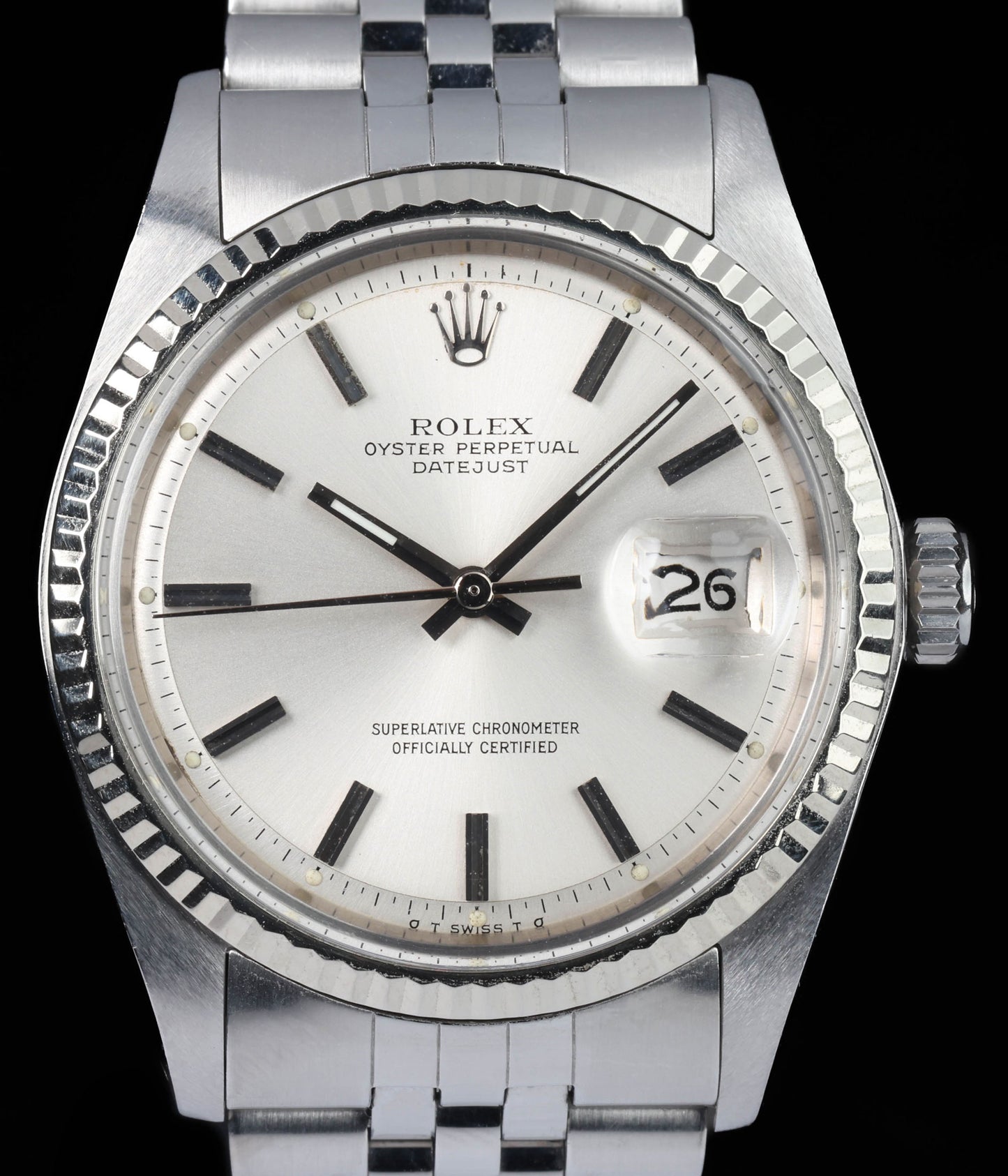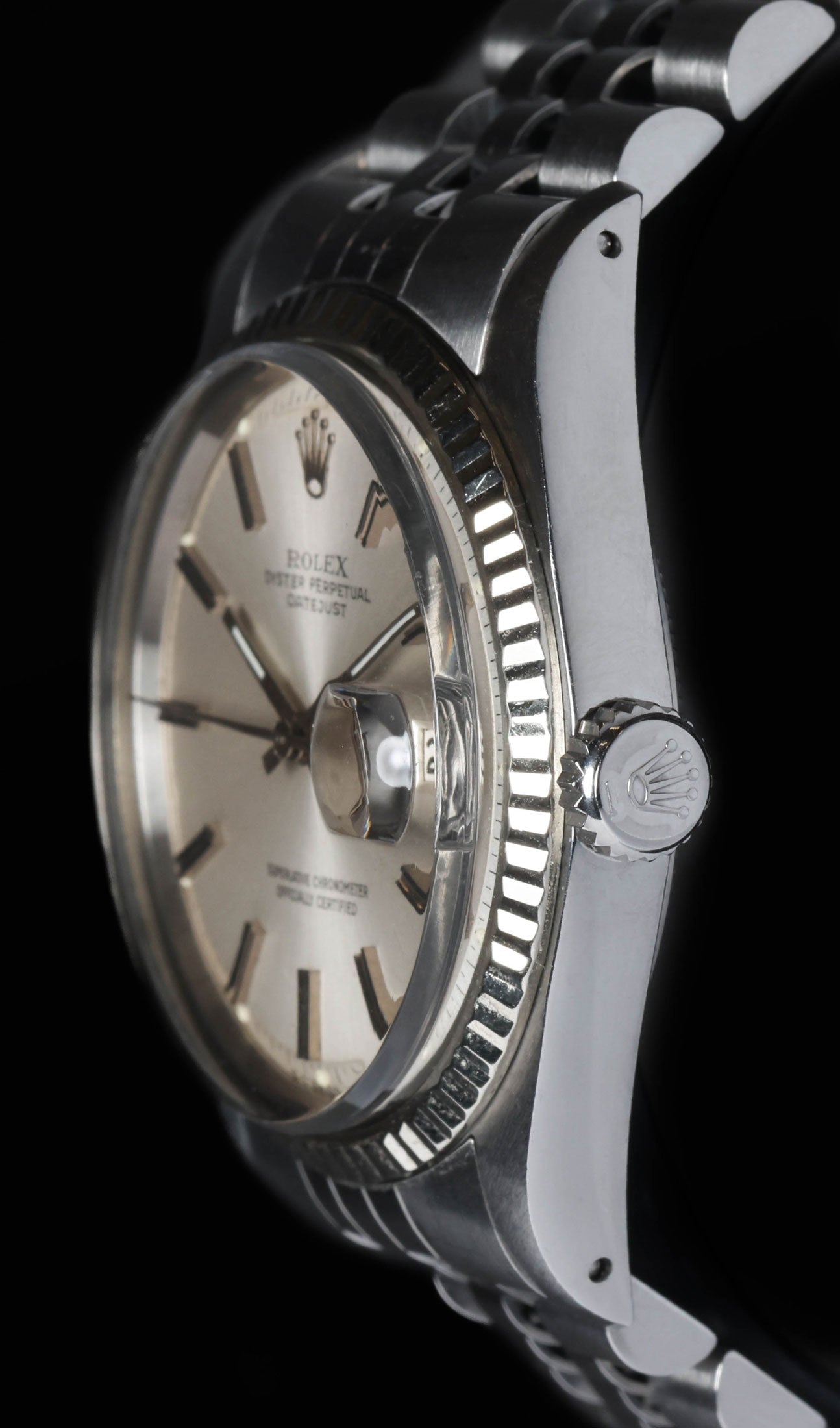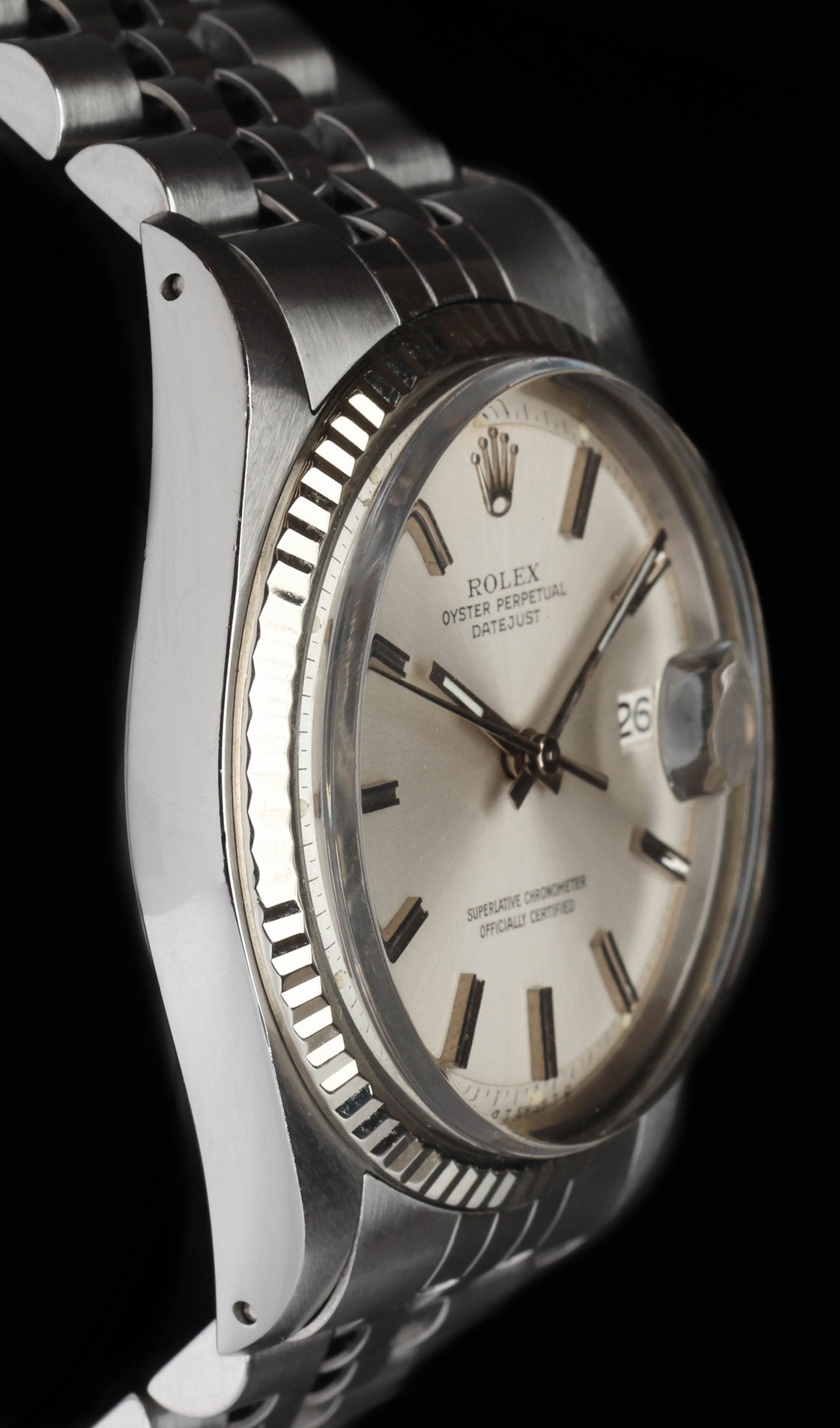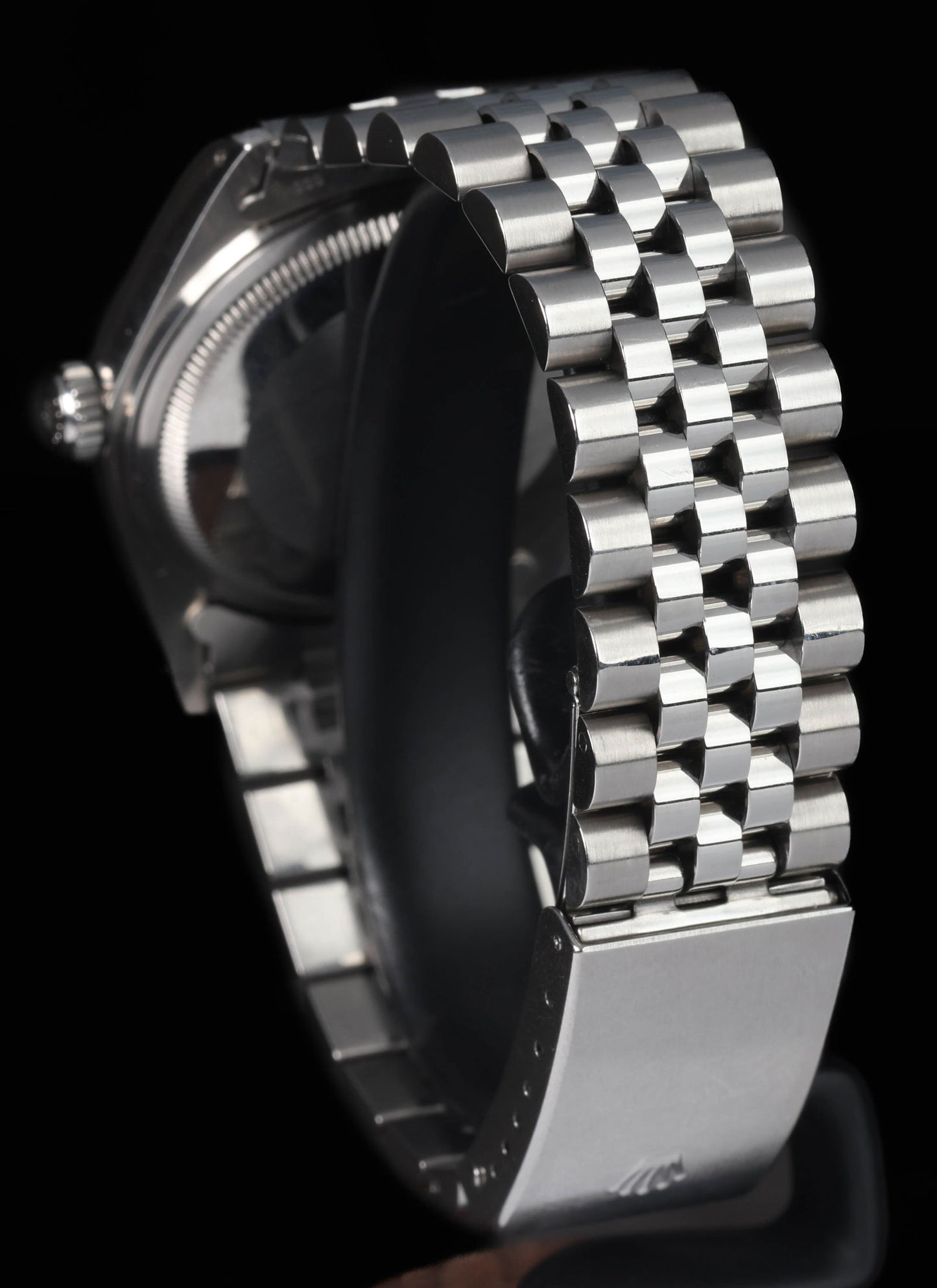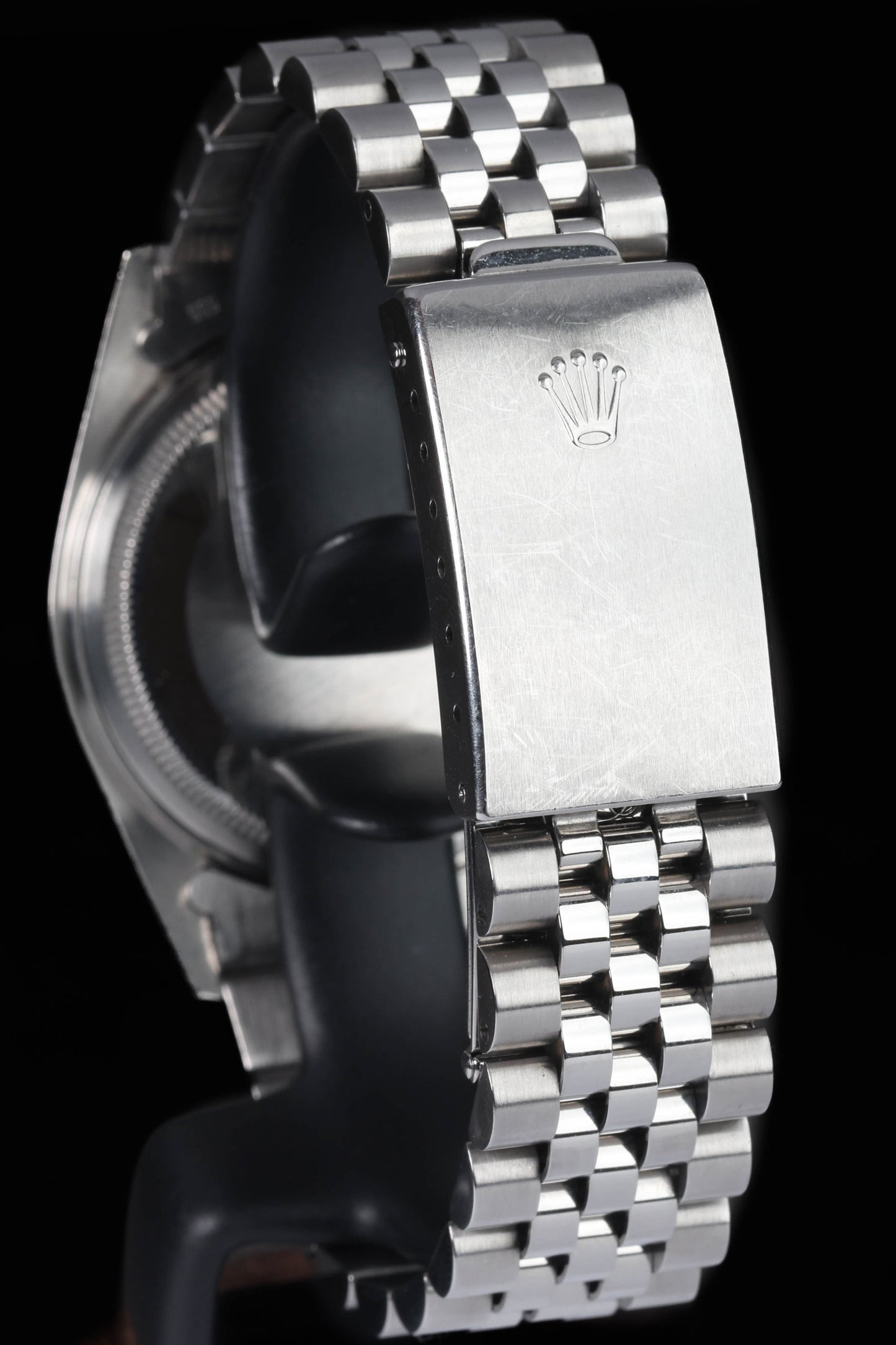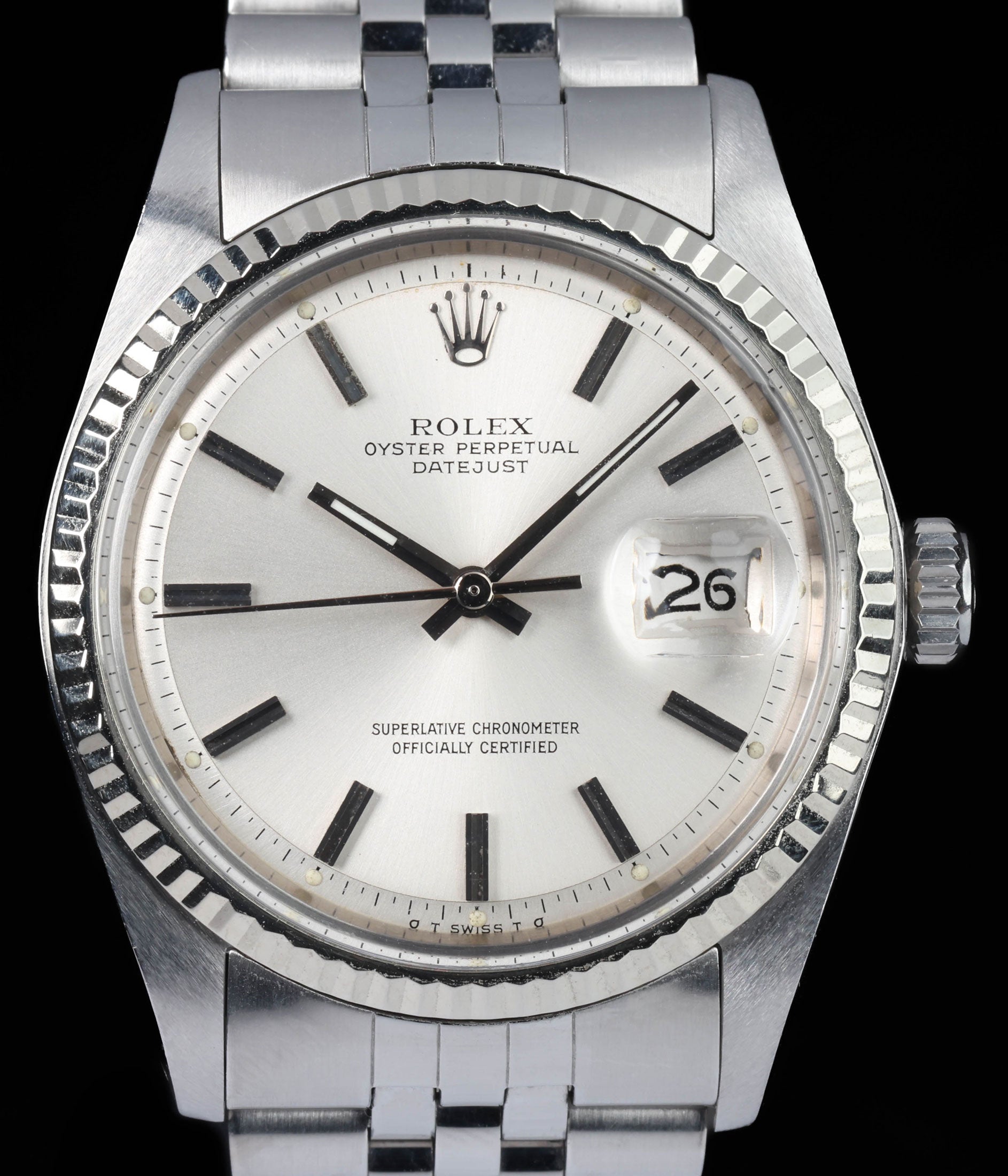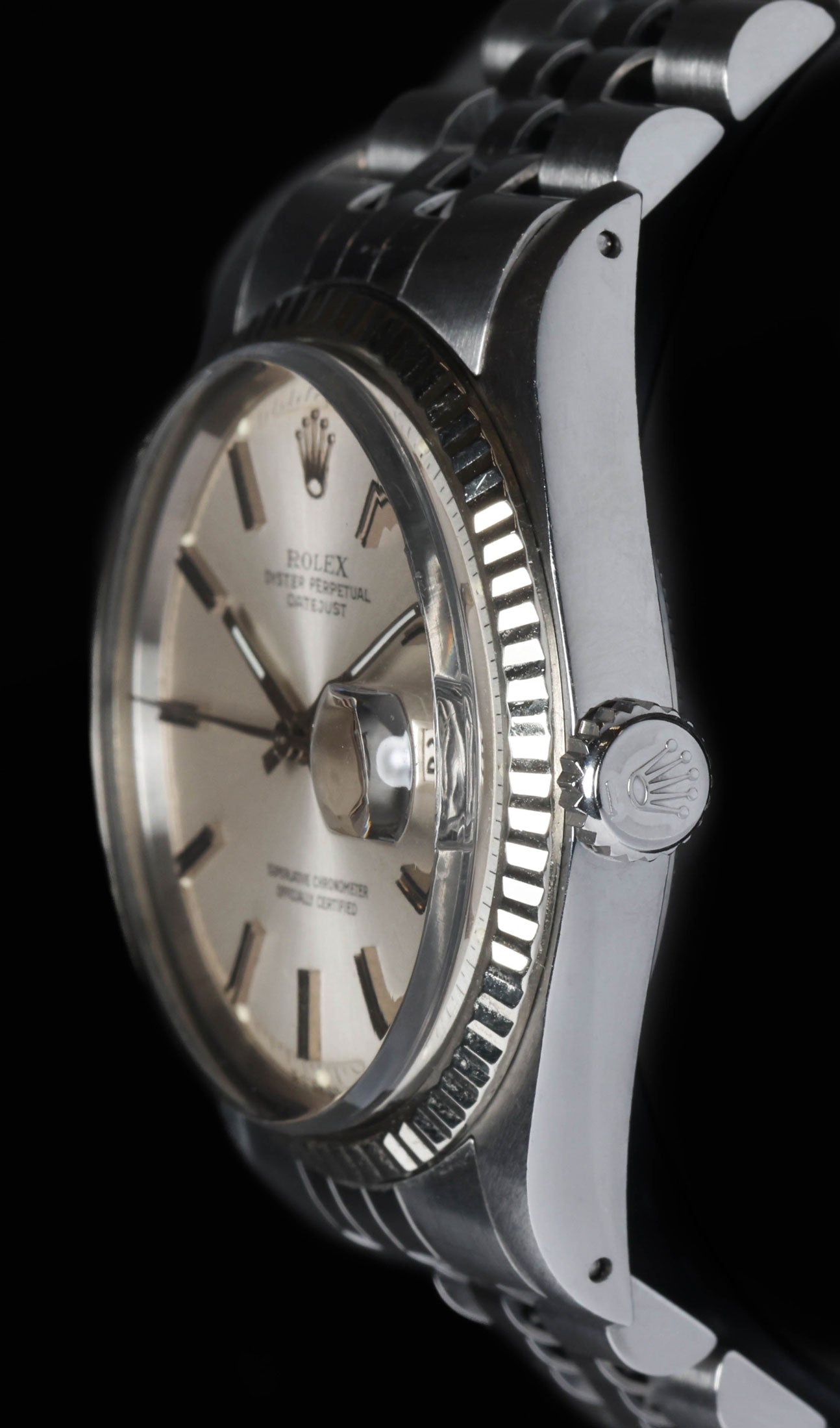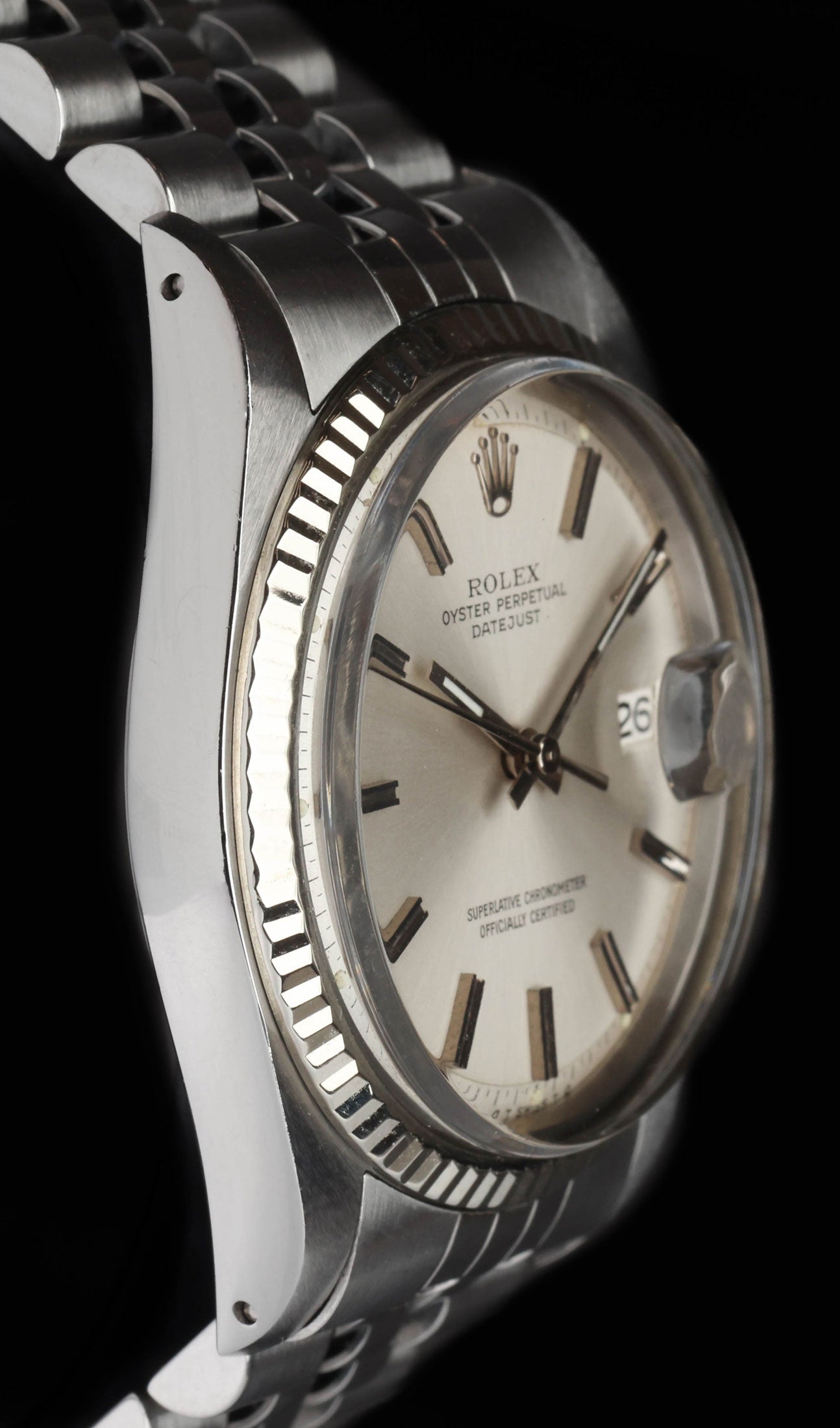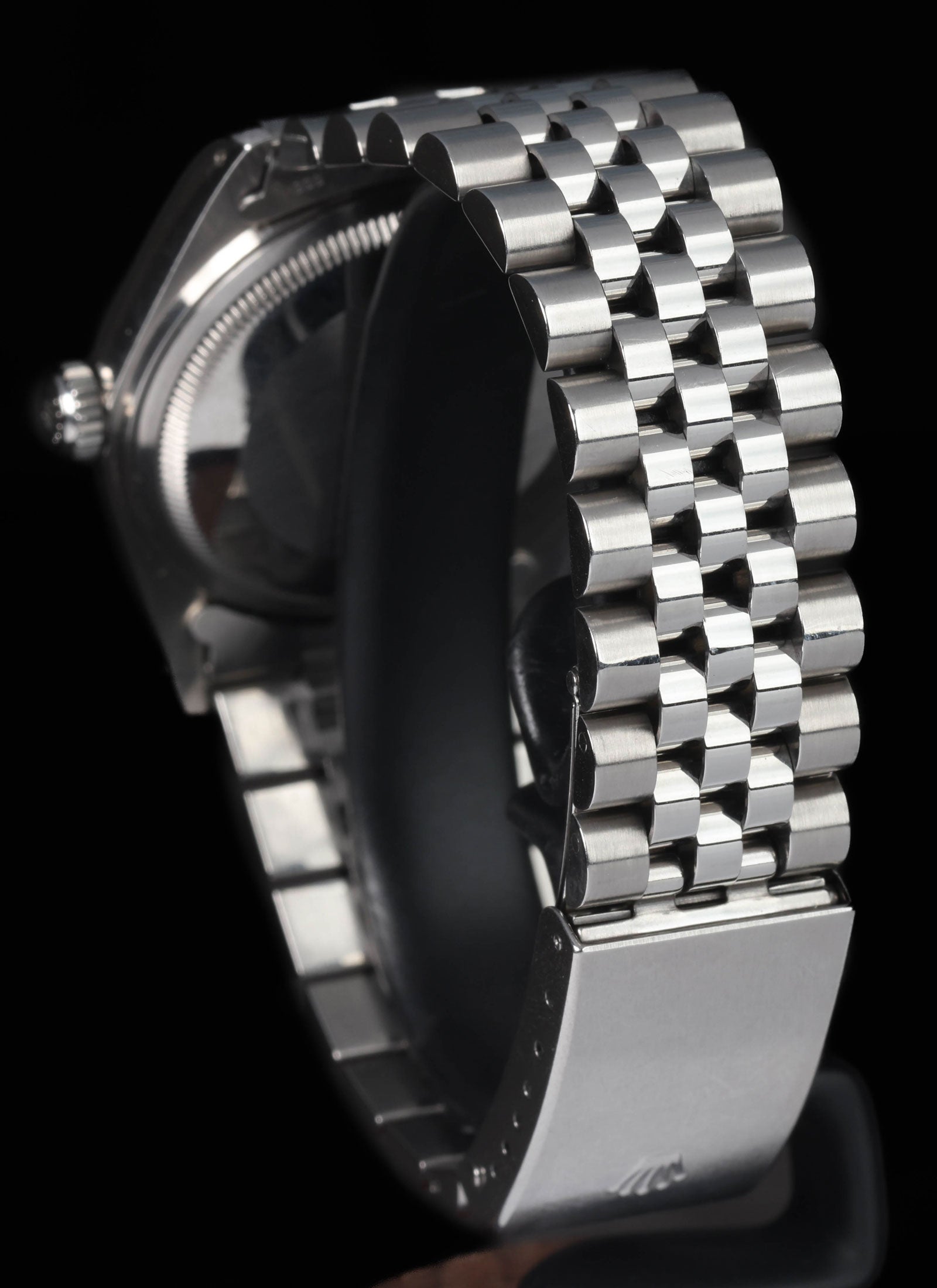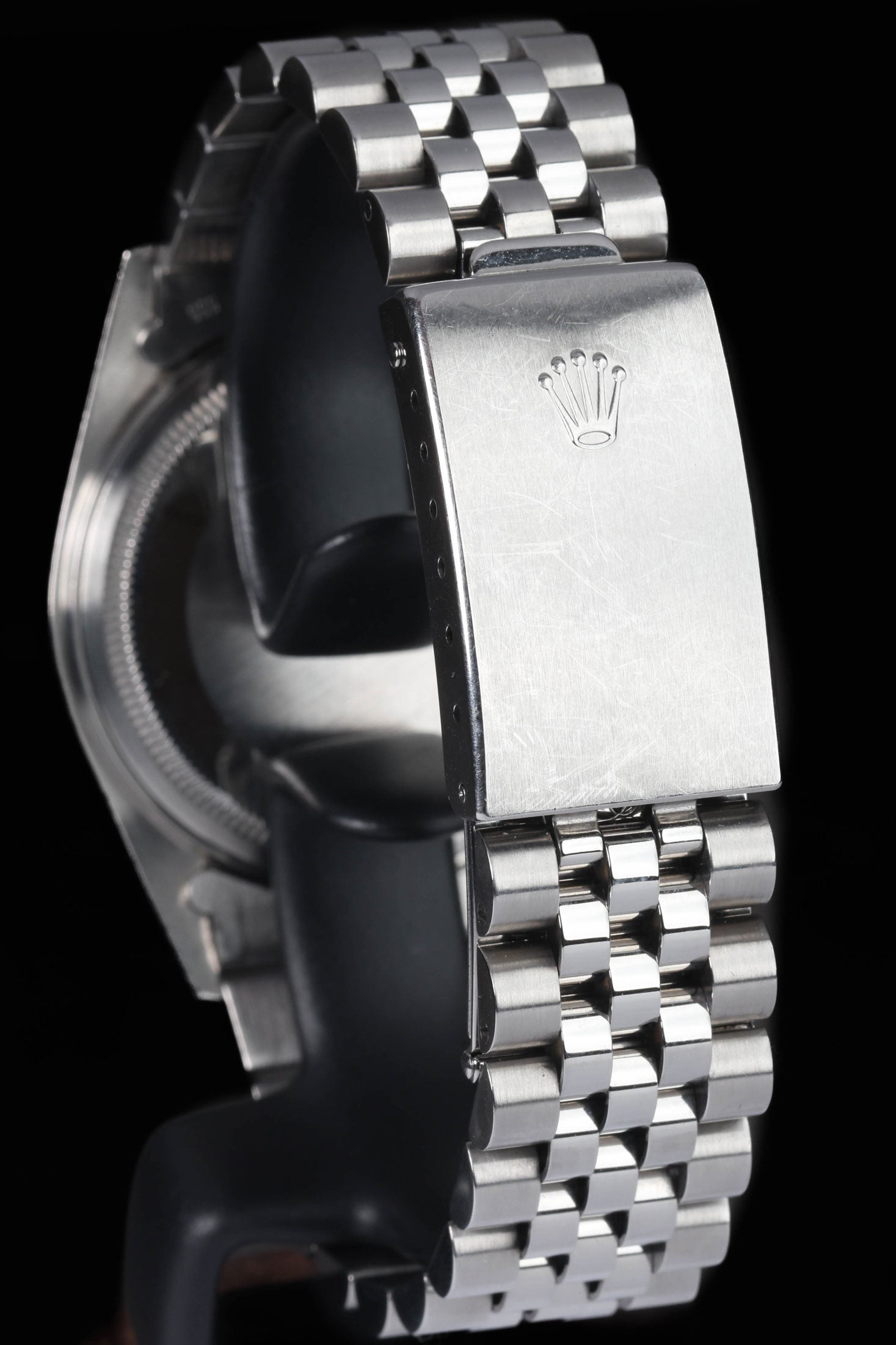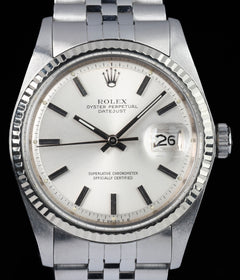Crown Vintage
Rolex Datejust 1601 'Sigma Dial' 36MM 1976
Rolex Datejust 1601 'Sigma Dial' 36MM 1976
Couldn't load pickup availability
Rolex Datejust 1601 'Sigma Dial'
Case is in excellent, unpolished condition with sharp lugs and original factory brushing still crisp. Bracelet likewise presents in excellent order, showing very minimal stretch and only light hairlines on the clasp. The acrylic crystal has been professionally polished and remains clear, free of deep marks. Dial and hands are in very good condition; all lume plots are intact and stable, and the sought-after sigma dial signature is clean and correct. Given its age, this watch should be treated as a vintage timepiece—avoid swimming or any water exposure.
Share
Why we love this watch
Why we love this watch
Rolex Datejust 1601 ‘Sigma Dial’ 1976
The Datejust Evolution
Rolex introduced the Datejust in 1945 to mark its 40th anniversary, delivering the first automatic wrist-watch that switched the date instantaneously at midnight. Across three decades the model matured into a universal companion thanks to its 36 mm Oyster case, combination of polished and brushed surfaces, and legible date display magnified by the Cyclops lens. By 1976 the Datejust had weathered the quartz disruption while remaining Rolex’s signature daily wearer—functional, elegantly proportioned, and mechanically robust.
Understanding Reference 1601
Produced from the late 1950s until the end of the 1970s, reference 1601 defines the four-digit Datejust era. It pairs a stainless-steel Oyster case with an 18 ct white-gold fluted bezel, illustrating Rolex’s formula of steel strength and gold refinement. The watch measures roughly 44 mm lug-to-lug and 12 mm thick (including acrylic crystal), dimensions that lend versatility across wrist sizes and dress codes. Serial numbers in the four-million range place an example squarely in 1976, the penultimate production year before Rolex transitioned to sapphire crystals and quick-set 3035 movements.
The Sigma Dial Explained
Early-1970s Swiss brands formed the APRIOR group to assure consumers of genuine precious-metal content amid rising gold prices and the growing prevalence of plated dial furniture. Dials meeting the standard carried small Greek sigma letters flanking “T SWISS T” at six o’clock, indicating that applied markers and hands were solid gold. On a steel 1601 those sigmas confirm white-gold components that resist tarnish and reflect light cleanly. The twin symbols also create pleasing symmetry, echoing the Rolex coronet at twelve and balancing the date aperture at three.
1976 Production Snapshot
During 1976 Rolex refined case finishing with sharper lug chamfers and more consistent brushing, the result of incremental machinery improvements in Geneva. Tritium remained the luminous compound of choice, but application techniques were tighter, resulting in smaller, more uniform plots compared with earlier 1960s dials. Movement parts were pre-assembled by Rolex Bienne, shipped to Geneva for casing, then adjusted to chronometer tolerances of −4 /+6 seconds per day; most well-serviced examples today still run within those parameters.
Case Architecture and Bezel Design
The Oyster case is machined from 904L stainless steel, prized for its resistance to pitting and its ability to hold sharp lines after careful polishing. Polished flanks catch ambient light, while satin upper lugs transition smoothly to a fluted white-gold bezel whose myriad facets act as a light-catcher rather than an overt status signal. A Twinlock crown compresses two internal gaskets when screwed down, providing a factory-rated 100 m depth resistance—ample for mid-1970s office workers but equally adequate for weekend sailing. Drilled lug holes simplify bracelet and strap changes, a beloved feature for modern enthusiasts who enjoy customising wear.
Dial Aesthetics
Most sigma dials from 1976 arrive in sunburst silver, champagne, slate, or rarer blue. The surface radiates from the cannon pinion, producing a dynamic shimmer that shifts under changing light. A gentle pie-pan recess leads into the minute track, adding depth absent from later flat dials. Baton markers receive black enamel stripes down their centres, contributing to at-a-glance legibility without crowding the dial. Tritium dots sit neatly on the outer edge of each marker, ageing to warm parchment tones that accentuate the watch’s vintage charm. Pencil-style hour and minute hands mirror the markers’ polished sheen and house slender tritium slivers, while the sweeping seconds hand glides across the dial with minimal stutter—testament to the movement’s free-sprung balance. At three o’clock, the date window is framed by a steel aperture, its numeral enlarged 2.5 times by the integral Cyclops bubble moulded into the acrylic crystal.
Calibre 1570 Movement
Inside ticks the 26-jewel calibre 1570, launched in 1965 and considered a cornerstone of Rolex reliability. The movement beats at 19 800 vph, balancing accuracy with reduced wear on pivots relative to higher-frequency rivals. A free-sprung Glucydur balance wheel anchored by a traversing bridge allows precise micro-stella screw timing adjustments, while the Breguet over-coil hairspring promotes concentric breathing in every position. Automatic winding is bi-directional via an efficient reverser-wheel system, delivering approximately 48 hours of reserve. Although lacking a quick-set feature (requiring hands to be advanced past midnight to change the date), the calibre retains robust parts availability and remains easily serviced by competent watchmakers.
Bracelet Choices and Ergonomics
The factory default for a steel 1601 in 1976 was the folded-link Jubilee bracelet reference 6251H, using 55 end-links to integrate with the case. Its five-link construction drapes smoothly over the wrist, tapering from 20 mm at the lugs to 16 mm at a stamped clasp that includes micro-adjust holes for fine fit. Customers seeking a sportier personality could specify the three-link Oyster 7836, whose broader brushed centre links and polished outer flanks echo Rolex sports models of the same era. Regardless of bracelet, head weight remains around 90 g, producing balanced centre-of-mass distribution that negates top-heaviness and allows all-day comfort for office, restaurant, or driving duties.
Wearing Experience
Strapping on a 1601 sigma dial in 2025 delivers immediate vintage charm without archaic fussiness. The 36 mm footprint sits comfortably on modern wrists, its slim profile sliding under tailored sleeves while the fluted bezel adds subtle sparkle in natural light. Acrylic crystals tend to collect superficial scuffs yet polish back quickly with polywatch, preserving clarity and imbuing warm optical distortion at oblique angles—an effect lost on sapphire. The radial dial finishing dances beneath that domed surface, shifting shades under café down-lights or bright Sydney sunshine. Hand-winding on Monday morning offers tactile engagement via the crown’s solid threading; the automatic rotor then maintains reserve through weekday commutes and meetings. Tritium plots may no longer shine brightly after sunset, yet their caramel patina provides charming evidence of decades quietly ticked away.
Design Significance
The Datejust 1601 sigma dial sits at an intersection of mechanical tradition and subtle luxury. Its white-gold bezel and dial furniture elevate a steel case without overt opulence, aligning with the understated preferences of many Australian professionals during the mid-1970s. The sigma marks add an extra narrative layer, speaking to an industry-wide push for material transparency during a turbulent economic period defined by inflation and bullion speculation. Moreover, the reference preserves hallmark Rolex design cues—Cyclops, fluted bezel, Oyster case, Jubilee bracelet—in proportions now considered near-perfect by vintage purists.
Enduring Appeal
Why does a 1976 sigma Dial Datejust remain compelling nearly five decades later? Firstly, it offers a wearable 36 mm case ideally suited to both casual and business settings—a versatility rarely matched by modern 41 mm offshoots. Secondly, the calibre 1570 continues to deliver chronometer-grade performance with straightforward servicing, ensuring longevity without high operating cost. Thirdly, sigma dials appear in fewer numbers than standard tritium prints, providing collectors with discreet rarity that does not rely on exotic colours or fragile lacquer. Finally, the watch captures Rolex’s evolutionary sweet spot: acrylic warmth, pie-pan dimensionality, and hand-finished details executed after decades of production refinement yet before mass-automation altered case and bracelet profiles.
Final Thoughts
A 1976 Datejust 1601 with a sigma dial delivers clear, tangible advantages for anyone who appreciates vintage Rolex. The 36 mm steel case keeps proportions wearable on a wide range of wrists, while the white-gold fluted bezel and gold batons confirmed by those discreet σ marks supply period-correct refinement without showiness. Beneath the dial, the calibre 1570 offers proven accuracy and straightforward servicing, and the acrylic Cyclops crystal gives the watch a warm, unmistakably 1970s look that sapphire can’t replicate.
Rarity adds further appeal. Sigma dials appeared only for a brief window in the mid-1970s, and many have since been replaced during servicing, so an untouched example provides both historical interest and subtle exclusivity. Combine that scarcity with the enduring practicality of the Datejust platform—easy parts availability, comfortable Jubilee bracelet, and a design that slides under a cuff—and the result is a watch that fits effortlessly into modern daily wear while retaining all the character of its era.
Case & Bracelet
Case & Bracelet
- Case in excellent condition unpolished. Sharp lugs and factory brushing visible.
- Bracelet in excellent condition with very minimal stretch. Light hairlines on clasp. Crystal has been polished.
Dial & Hands
Dial & Hands
- Dial and hands are in very good condition.
- Lume plots intact. Sigma dial.
Warranty & Condition
Warranty & Condition
Crown Vintage Watches provides a minimum 3-month mechanical warranty on pre-owned watches, from the date of purchase.
The warranty covers mechanical defects only.
The warranty does not cover damages such as scratches, finish, crystals, glass, straps (leather, fabric or rubber damage due to wear and tear), damage resulting from wear under conditions exceeding the watch manufacturer’s water resistance limitations, and damage due to physical and or accidental abuse.
Please note, water resistance is neither tested nor guaranteed.
Shipping and insurance costs for warranty returns to us must be covered by the customer. Returns must be shipped via traceable courier. Return shipment must be pre-paid and fully insured. Collect shipping will be refused. In case of loss or damages, the customer is liable.
Our Pledge
At Crown Vintage Watches, we stand by the authenticity of every product we sell. For added peace of mind, customers are welcome to have items independently authenticated at their own expense.
Condition
Due to the nature of vintage timepieces, all watches are sold as is. We will accurately describe the current condition and working order of all watches we sell to the best of our ability.
Shipping & Refund
Shipping & Refund
